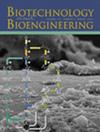模块化RNAi途径工程增强酵母生物生产系统中质粒拷贝数控制
IF 3.5
2区 生物学
Q2 BIOTECHNOLOGY & APPLIED MICROBIOLOGY
引用次数: 0
摘要
合理设计微生物细胞工厂需要精确协调基因剂量和表达动态,以优化代谢通量,同时最大限度地减少细胞负担。在本研究中,在酿酒酵母的正交RNA干扰(RNAi)系统重建后,发现了意想不到的质粒拷贝数扩增,并开发了一个具有动态可编程质粒拷贝数的合成生物学底盘。通过整合来自castellii Saccharomyces的外源RNAi通路基因,并设计序列特异性小干扰rna (sirna)靶向质粒编码选择标记,我们建立了一个化学诱导的基因剂量控制平台,能够实现质粒拷贝数扩增达7.13倍。将RNAi介导的拷贝数调节应用到类胡萝卜素生物合成途径中,与静态质粒系统相比,番茄红素滴度增加了18.6倍。本研究提出了一种创新的酿酒酵母动态质粒拷贝数调控方法,以实现高效的基因剂量控制,进一步丰富了合成代谢调控的工具箱。该策略在提高微生物细胞工厂的生产性能方面显示出巨大的潜力,并为合成生物学框架内的代谢工程优化提供了新的视角。本文章由计算机程序翻译,如有差异,请以英文原文为准。
Modular RNAi Pathway Engineering Enhances Plasmid Copy Number Control in Yeast Bioproduction System
Rational design of microbial cell factories requires precise coordination of gene dosage and expression dynamics to optimize metabolic flux while minimizing cellular burden. In this study, an unexpected plasmid copy number amplification was identified following the reconstruction of an orthogonal RNA interference (RNAi) system in Saccharomyces cerevisiae , and a synthetic biology chassis with dynamically programmable plasmid copy numbers was developed. By integrating heterologous RNAi pathway genes from Saccharomyces castellii and designing sequence‐specific small interfering RNAs (siRNAs) targeting plasmid‐encoded selection markers, we established a chemically inducible gene dosage control platform capable of achieving plasmid copy number amplification up to 7.13‐fold. Application of this RNAi‐mediated copy number modulation to the carotenoid biosynthetic pathway resulted in an 18.6‐fold increase in lycopene titers compared to static plasmid systems. This study presents an innovative approach for dynamic plasmid copy number regulation in S. cerevisiae to enable high‐efficiency gene dosage control, further enriching the toolkit for synthetic metabolic regulation. This strategy exhibits significant potential for enhancing the production performance of microbial cell factories and offers novel perspectives for metabolic engineering optimizations within the synthetic biology framework.
求助全文
通过发布文献求助,成功后即可免费获取论文全文。
去求助
来源期刊

Biotechnology and Bioengineering
工程技术-生物工程与应用微生物
CiteScore
7.90
自引率
5.30%
发文量
280
审稿时长
2.1 months
期刊介绍:
Biotechnology & Bioengineering publishes Perspectives, Articles, Reviews, Mini-Reviews, and Communications to the Editor that embrace all aspects of biotechnology. These include:
-Enzyme systems and their applications, including enzyme reactors, purification, and applied aspects of protein engineering
-Animal-cell biotechnology, including media development
-Applied aspects of cellular physiology, metabolism, and energetics
-Biocatalysis and applied enzymology, including enzyme reactors, protein engineering, and nanobiotechnology
-Biothermodynamics
-Biofuels, including biomass and renewable resource engineering
-Biomaterials, including delivery systems and materials for tissue engineering
-Bioprocess engineering, including kinetics and modeling of biological systems, transport phenomena in bioreactors, bioreactor design, monitoring, and control
-Biosensors and instrumentation
-Computational and systems biology, including bioinformatics and genomic/proteomic studies
-Environmental biotechnology, including biofilms, algal systems, and bioremediation
-Metabolic and cellular engineering
-Plant-cell biotechnology
-Spectroscopic and other analytical techniques for biotechnological applications
-Synthetic biology
-Tissue engineering, stem-cell bioengineering, regenerative medicine, gene therapy and delivery systems
The editors will consider papers for publication based on novelty, their immediate or future impact on biotechnological processes, and their contribution to the advancement of biochemical engineering science. Submission of papers dealing with routine aspects of bioprocessing, description of established equipment, and routine applications of established methodologies (e.g., control strategies, modeling, experimental methods) is discouraged. Theoretical papers will be judged based on the novelty of the approach and their potential impact, or on their novel capability to predict and elucidate experimental observations.
 求助内容:
求助内容: 应助结果提醒方式:
应助结果提醒方式:


